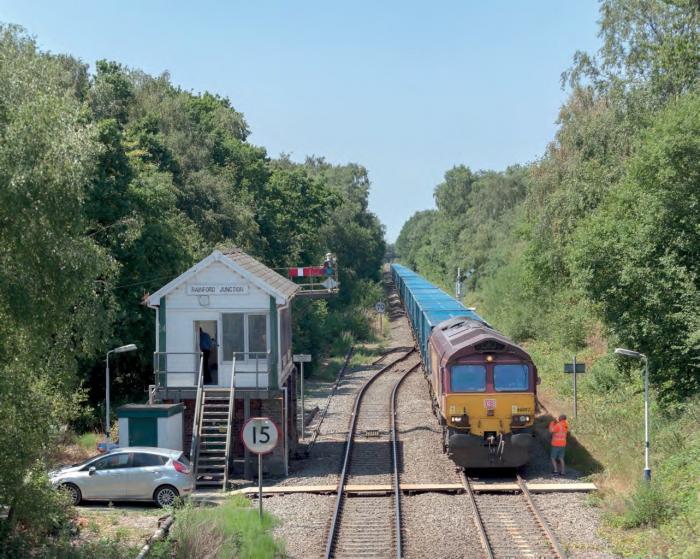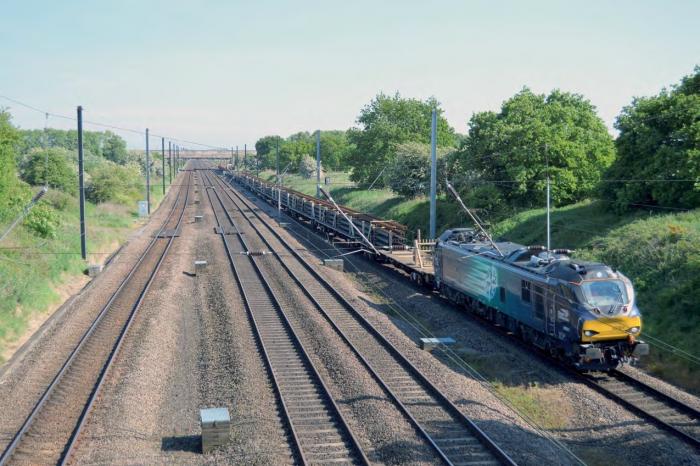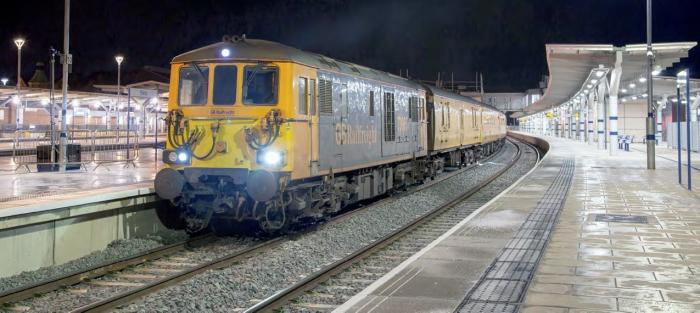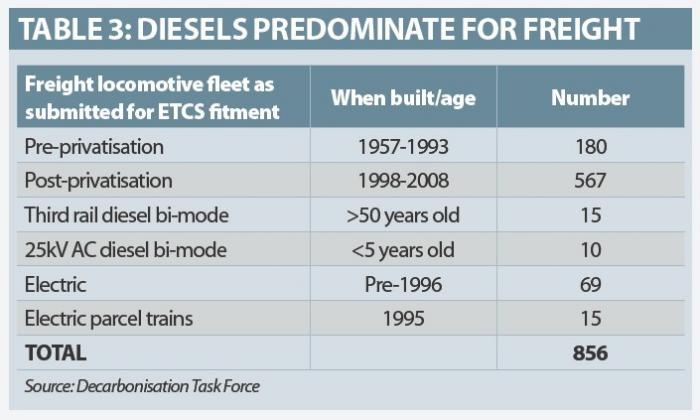Informed Sources
For MegaWatts it’s diesel or electrification
If you read this column, I’m sure you enjoyed my colleague Ian Walmsley’s hatchet job (I think you mean ‘measured analysis’ – Ed) on the initial report of the Rail Industry Decarbonisation Task force in his column last month. What struck me about the report was the complex web of cognitive dissonances that vitiated the underlying common sense. This is exemplified by the report’s section on freight, reproduced here in the box. Note the uncharacteristically realistic (this is a Rail Safety & Standards Board [RSSB] production) second bullet point. It is an inescapable fact that nothing can match the diesel engine’s combination of power, range and, incidentally, efficiency and affordability, when it comes to a prime mover you can put in a UK-gauge 125-tonne Co-Co locomotive.
But having established that Mr Ackroyd Stuart’s creation many generations removed in EU Stage IIIB configuration is about as clean – but not necessarily green – as it comes, the report remembers that RSSB has a research budget to burn through and decides that bi-mode and battery technology could deliver ‘significant’ improvements and recommends further research and development into solving this ‘challenge’.
Similarly, the report observes that the diesel engine in the Stadler state-of-the-art Class 88 bi-mode gives only 20% of the power available running under the wires. This makes it suitable for only slow speed last mile operation, the report adds. Amazing!
But while the limitations of the UK gauge mean that there is insufficient space, with current technology, to fit an electric locomotive with sufficient installed diesel power to supersede the Class 66, the report’s authors don’t give up. Work is under way that ‘may’ lead to the development of locomotives that ‘would’ use smaller diesel engines and supplement this with battery power. This technology might in due course be applied to freight locomotives.
And guess what? ‘Further work is needed to develop suitable bi-mode options with sufficient versatility across the network to be viable. The sector would need innovation funding support to develop options such as these and to develop a clearer understanding that the necessary capital investment would lead to reasonable returns in reduced operating costs as well as reduced emissions. The lack of such support presents a significant barrier.’ Talk about broad hints.
FREIGHT DIESELS PRESENT CHALLENGES
■ The removal of diesel only freight and maintenance (Yellow Rail) trains from the national rail network presents unique challenges.
■ There is no alternative independent power source available, which delivers the power and range necessary to meet the specific demands of these uses.
■ The introduction of bi-mode and battery technology, while a challenge, could deliver significant improvements.
■ We recommend further industry-led research and development into solving this challenge.
■ In the near term the freight industry will continue to reduce unit carbon emissions through further maximising payload per train, employing driver advisory systems, auto stop-start and other system-level innovations.
Rail Industry Decarbonisation Task Force, January 2019

TECHNOLOGY
This report’s conclusions highlight the problem facing the railway industry in various of its current dealings with a Government ruled by policy-based evidence. I can’t better the observation of a perceptive chum who explained that ‘if you press too hard for reality of thinking, you lose the argument politically just now’.
Personally, I have always believed that there is no point in being obliging with Government because it can’t and won’t reciprocate. That said, since the industry made electrification unaffordable without outside assistance, it has been hard to counter the Government’s enthusiasm for bi-modes, batteries and hydrogen. Hopefully the McNaughton (p24, last month) and Railway Industry Association reports will have turned the tide. But when it comes to the need to decarbonise freight traction in response to the Johnson Doctrine (see box), I would have liked to have seen a more robust defence of the industry. Emissions statistics make variable track access charges look simple. However, I calculate that while rail freight is responsible for roughly 10% of the UK’s total freight tonne kilometres (rail and heavy goods vehicles) it generates 3% of the total CO2 emissions generated.
Put another way, for each tonne of CO2 produced, HGV traffic generated 8,000 tonne kilometres, compared with 28,500 for rail. But that’s the steel wheel on steel rail for you. To its credit, the report does remind Government that ‘there is currently no low or zero carbon alternative to diesel for road haulage, other than for local delivery vans’.
It adds: ‘this presents rail with a unique opportunity to offer low carbon freight transportation if greater use can be made of existing and future electrification. It follows that priority ought to be given to future electrification schemes for those mixed traffic lines that carry a significant volume of freight’.
ALTERNATIVES
JoJo’s challenge is characteristically vague. Note that it refers only to petrol and diesel cars, not HGVs. And ‘diesel-only trains’ provides fertile ground for unintended consequences. Far better to have set targets, sorry ‘ambitious targets’, for CO2 reduction and left the rail freight industry to work out how to achieve them.
Meanwhile, it is time to examine the final two paragraphs in the challenge: the technical vision of bi-modes leading into battery storage and ultimately hydrogen fuel cell power. Despite reiterating that there is no alternative independent power source available for diesel-only freight and maintenance (yellow) trains, the Decarbonisation Task Force report still buys into the credo that bi-mode and battery technology, ‘while a challenge, could deliver significant improvements’.
As C. M. Joad would have said, ‘it all depends on what you mean by “significant”’. Let’s start with batteries.
HARD
Time for some hard numbers. Lithium ion batteries currently have a maximum energy density at cell-level of 250Wh/kg. In practice, to maintain service life these batteries must not be fully charged or discharged. Various ranges are quoted. The most optimistic limits I have seen are between 10% and 90% charge, with 20%-80% also given. The Decarbonisation Task Force report is the most pessimistic at 30%-70%.
Then you have to put the battery cells in a housing that includes the supporting auxiliary equipment. This raft also has to absorb heavy shunt shock loads, which adds further weight. This is known as ‘pack-level’ energy density.
In one current aviation application, the pack-level energy density of Li Ion batteries is quoted at 143Wh/kg. However, my analysis of the battery packs in the three UK battery hybrids (‘Informed Sources’, May 2018) showed a real life pack-level energy density of 50Wh/kg. But let’s stick with 250Wh/kg because it is almost exactly one-third of a horsepower hour (hph).
Sorry, electrical engineers.
STORMY
Back in 1991, I footplated British Rail’s ultimate heavy-haul locomotive, the Brush Class 60, taking on the ultimate heavy haul challenge – hauling a 3,000-tonne iron ore train from Port Talbot to Llanwern, including the ascent of Stormy Bank with its final 1:92 gradient.
THE JOHNSON CHALLENGE
‘I would like to see us take all diesel-only trains off the track by 2040. If that seems like an ambitious goal – it should be and I make no apology for that. After all, we’re committed to ending sales of petrol and diesel cars by 2040. If we can achieve that, then why can’t the railway aspire to a similar objective? ‘Rail may be less carbon intensive than road transport. That’s why modal shift’s so important. Getting freight and passenger vehicles off the roads onto greener forms of transport. But that does not absolve the rail industry from cleaning up its own act.
‘New bi-mode trains are a great bridging technology to other low emission futures. And as battery technologies improve we expect to see the diesel engines in bi-modes replaced altogether. With batteries powering the train between the electrified sections of the network. ‘Or maybe in the future we could see those batteries and diesel engines replaced with hydrogen units? Alternative-fuel trains powered entirely by hydrogen are a prize on the horizon.’
Jo Johnson, Transport Minister, 12 February 2018

Leaving the sidings, as soon as we were on the main line at 10.59 the driver of the Class 60 selected full power. The mighty Mirrlees MB275 then proceeded to pour out its 3,100hp until, five miles later, at 11.19, we topped Stormy Bank, to a creep-scream accompaniment, at 11mph. So, 20 minutes at 3,100 is as near as dammit 1,000hph. To supply this you would need 3.3 tonnes of Li Ion batteries at cell level.
SEDUCTIVE
Of course, the hybrid diesel-battery locomotive hinted at in the report would have a smaller engine with a large battery pack to provide extra grunt when accelerating or climbing. With regenerative braking some energy could be recovered on down grades. It sounds seductively simple.
But apart from pack-level energy densities and the charge and discharge limitations, there is another issue with batteries. Power equals volts multiplied by amps. Freight traction involves a lot of constant high power. As you discharge a battery, the voltage drops, which means increasing the current to maintain constant power. Increase the current and the voltage drops even faster. Batteries don’t like this death spiral treatment.
AFFORDABLE?
Costs of Li Ion batteries have been falling dramatically as mass production has built up. Car maker Tesla, with its own battery ‘giga-factory’, claims to be approaching $100 (£75) per kWh at cell level. Other sources suggest current commercial prices are around $150 (£110) per kWh. Pack-level adds around 30% to the specific cost.
But if someone wanted to convert, say, a spare Class 47 to demonstrate a diesel/battery hybrid it wouldn’t cost an arm and a leg. That’s something BR Research would probably have done by now.
HYDROGEN
Of course, hydrogen is the dream solution. I don’t think anyone is contemplating a hydrogen-powered Class 66 replacement, so I’ll keep it brief. For a start, hydrogen fuel cells lack ‘driveability’. You can’t just couple the terminals from your fuel cell to a traction inverter and shove the controller into notch 7.
Fuel cells need a battery buffer to provide the variable grunt needed by electric motors. For example, the latest Hyundai fuel cell car has a drive motor rated at 120kW (161hp). The fuel cell puts out 95kW (127hp) and feeds a 1.56kWh (2.1hph) battery that powers the electric motor.
Similarly, the production Alstom Coradia iLint hydrogen multiple-unit has a 200kW (270hp) fuel cell stack feeding a water-cooled 111kWh (115hph) Li Ion battery. This in turn feeds the traction package. The aim is to run the fuel cell at half power, with the battery evening out the load. Incidentally, in the course of researching this article I asked Alstom for the weight of the iLint battery, only to be told ‘at this stage the mass of the batteries is not public’. How odd.
Anyway, when it comes to freight traction, Ballard has supplied a 250kW (335hp) fuel cell to power a BNSF ‘switcher’ locomotive. So think Class 08 rather than Class 66 replacement.
CONTRARY
While the biggest reduction in emissions will come from transferring freight from road to rail plus a rolling programme of electrification, if freight diesels are to run on long-term, we need to do our bit. Consider diesel emissions regulations (Table 1, overleaf). These are confined to carbon monoxide, hydrocarbons, nitrous oxides and particulate matter – the emissions that damage people. But typing this during the warmest-ever February days, the absence of CO2, which damages the earth, seems perverse.
CO2 is the product of combustion. The more fuel you burn, the more CO2 you produce. Diesel engine fuel consumption is measured in grams of fuel required to generate one kilowatt hour (g/kWh). In its day, the Mirrlees MB275 set a new benchmark at 195g/kWh. To illustrate how technology has improved, the English Electric 12CSVT engines in the triple-headed Class 37s that topped Stormy Bank at 17mph when I first footplated the iron ore trains in 1976 were consuming 228g/kWh on full power.
MORTGAGE
Now comes the conundrum. The more efficient an engine, the less fuel it burns and the less CO2 it generates per horsepower. However, to get NOx emissions down you have to mortgage combustion efficiency. When Wisconsin Central bought the BR freight businesses and formed EWS, it brought in Jim Fisk as Chief Engineer. Back in the States, Mr Fisk had been used to running heritage General Motors locomotives with lusty, but thirsty, two-stroke engines.
When he was buying the Class 66 fleet for operation in the UK, Jim Fisk waxed strongly to me about the perversity of the need to meet the nitrous oxide (NOx) emissions, which meant that the fuel consumption of his new locomotives went to pot. And the GM two-stroke was nowhere near as fuel thrifty as the Mirrlees in the first place.
To illustrate the effect of NOx reduction on CO2 production, Table 2 shows the fuel efficiency of the same model of MTU engine under the United States Tier 2 and Tier 3 emissions regulations. Tier 3 is the equivalent of the Euro Stage III in Table 1. Some quick calculation indicates that the difference between Tier 2 and Tier 3 would save around 17kg of CO2 on that climb to Stormy summit.
So what can be done to make diesel engines even more fuel efficient?




There are ways of achieving this, but it can be hard to fit the additional technical features into a locomotive. For example, Wärtsilä, which makes those massive ‘cathedral’ engines for ships and power stations, is in the Guinness Book of Records as manufacturing the most efficient diesel engine, with a specific fuel consumption of 165g/kWh.
And while the MTU engine in the IC125 power cars gives 206g/kWh at rated power, at the most efficient point on the fuel consumption curve this falls to 190g/kWh. This is with Euro Stage IIIa emissions levels.
FUEL SAVING
While more efficiency could be squeezed out of the diesel engine, good housekeeping is likely to be the most fruitful option. Stop/ start, where engines are shut down rather than left idling, is already being applied. Fuel-efficient driving will benefit from Connected Driver Advisory Systems (C-DAS). Traffic Management should make it easier to keep heavy freight trains rolling, preserving hard won kinetic energy.
TRACTION
So much for the politics and theory. What is the reality of the freight locomotive fleet in the context of the Johnson Challenge? Table 3 is taken from the report. Table 4 translates this into hardware. Fleets with modern emissions-compliant engines are highlighted in green. I have not bothered with heritage locomotives such as Class 37 and Class 57. Table 5 shows the freight electric traction fleets.
For the nominal withdrawal date I have assumed a 40-year book life. But as we know, traction equipment is noted for its longevity. Table 4 highlights the dependence of the freight hauliers on the Class 66, which represents 70% of the total freight diesel fleet. Table 5 reminds us of the limited current use of electric traction. In terms of emissions the Class 66 engine is probably acceptable, but CO2 will be relatively high compared with modern four-stroke engines.
General Motors was paranoid about fuel consumption and, unlike other manufacturers, never published specific fuel consumption figures. The closest I ever got was a graph in a British Rail conference paper in 1987. This included ‘worst new engine’ at 216g/kWh when the best new engine (presumably the Mirrlees) gave 198g/kWh. Since the freight hauliers are the most realistic operators on the network we can rule out re-engining or re-purposing Class 66s as an economic option. Good housekeeping will see the main reductions.
FUTURE TRACTION
Since the laws of physics and chemistry rule out pure battery or hydrogen fuel cell 3 MegaWatt (4,000hp) freight locomotives, from around 2035 we are going to need to start replacing the diesel locomotives for freight haulage on the routes yet to be electrified. Here the good news is that a modest rolling programme could have added 2,000 routes miles to the electrified network by 2040. And as the Decarbonisation Task Force notes, new electrification should be focused on mixed traffic routes carrying high volumes of freight.
Even if only half the Class 66 fleet has to be replaced, that represents a worthwhile investment in research and development by a locomotive builder and diesel engine supplier. The priority would be to produce a low CO2 locomotive with the performance of a 4,000hp diesel.
Why the higher power? On a congested passenger railway you are going to have to run faster, longer and heavier trains. Those Class 60s grinding up Stormy Bank at 11mph would not get on the timing graph today.
HYBRID
Extension of electrification will reduce the length of the last miles beyond the end of the wires, making increased use of electric traction viable. Here the challenge will be to provide sufficient diesel traction power and range. Stadler’s Class 93 ‘tri-mode’ locomotive ordered by Rail Operations Group (‘Pan Up’, February 2019) provides an interesting preview.




It builds on the Class 88, which adds a 700kW (940hp) Caterpillar diesel engine to a 4MW 25kV AC Bo-Bo electric locomotive. In effect, when off the wire, you have a Class 20 equivalent in terms of traction horsepower, ideal for taking container trains in and out of the Felixstowe port network if low-cost overhead line electrification was installed on the 16-mile branch between Ipswich and the Port of Felixstowe.
With the Class 93, some clever packaging has squeezed a more powerful 900kW (120hp) diesel engine plus a Lithium Titanate Oxide (LTO) battery rated at 400kW into the Eurolight platform. This gives a short-term (6-7 minutes has been quoted) power boost to 1,740hp. Stadler was unable to provide information on the type of engine or the capacity of battery pending contract signature. What we do know is that LTO sacrifices maximum energy density in return for the type of rugged battery needed for rough, tough freight locomotive use.
Table 6 is from a company that produces both types of Lithium Ion battery. As you can see, for a given capacity an LTO battery will be heavier. On the other hand it can use all of the charge, can be discharged and charged quickly and has a high output.
FUTURE POLICY
Long-term freight traction policy is full of known unknowns. The extent of any rolling programme of electrification that emerges from the current revival, and routes covered, is top of the list. Traffic to be hauled is another – although it is a reasonable assumption that trains will be longer and faster.
Certainly diesel traction will continue to be required. A basic performance requirement built round a really demanding CO2 focused emissions specification, for delivery starting from 2035, could produce some innovative offers. While there is some scope to squeeze a bit more useful energy out of each gram of fuel, a diesel battery hybrid locomotive offers a short-term power boost plus regenerative braking. However, to validate the concept, more work needs to be done on freight duty cycles on the key routes in terms of power demand to determine how much battery boost would be needed.
FLIGHT PARALLEL
Interestingly, a European study into electric-powered airliners under the Clean Skies research programme showed that the most effective option was to use a battery to power an electric motor providing extra power to the fan of the jet engine during take-off and climb.
This would allow the use of smaller turbofans to run at the more efficient constant operating point during the cruise (see the MTU data mentioned above). A theoretical 10% fuel saving was predicted. Mind you, that study assumed double the energy density available from today’s batteries. As for the last mile conundrum, while the Class 93 looks promising, it is oriented towards Rail Operations Group’s specific range of services. If you need to fit diesel engines and batteries into an electric locomotive specifically for freight then a Co-Co configuration gives you another 20 tonnes on a 17.5-tonne axle load.
I am conscious that readers may see my argument that electrification is the only credible replacement for freight diesel locomotives as a counsel of despair in the face of global warming. But as the cold numbers show, rail freight’s CO2 emissions are infinitesimal on a national transport, let alone global transport, scale. If we are to keep freight moving with the lowest environmental harm, the steel wheel on steel rail – even with diesel traction – is, if not the best, the least worst option.

